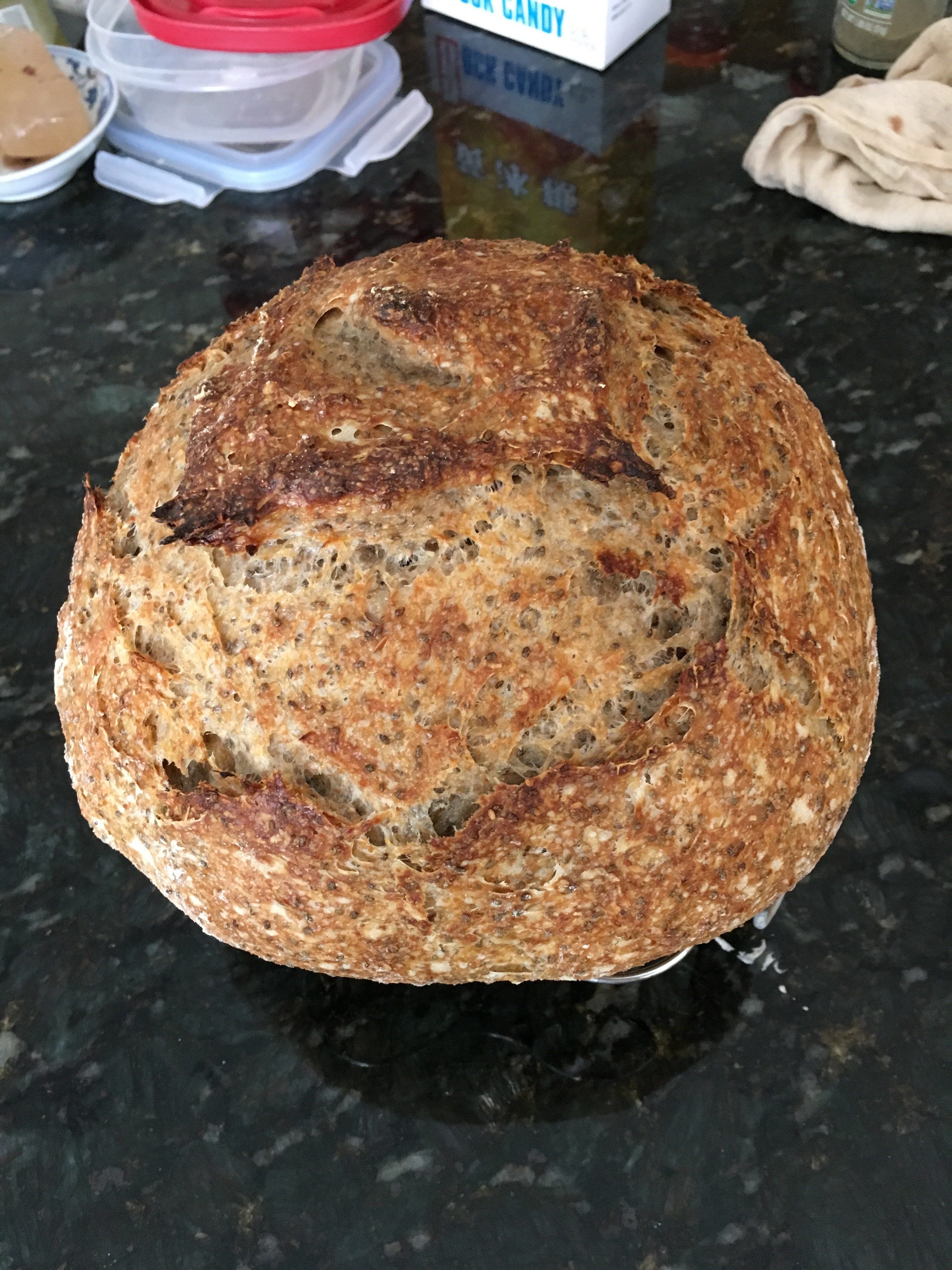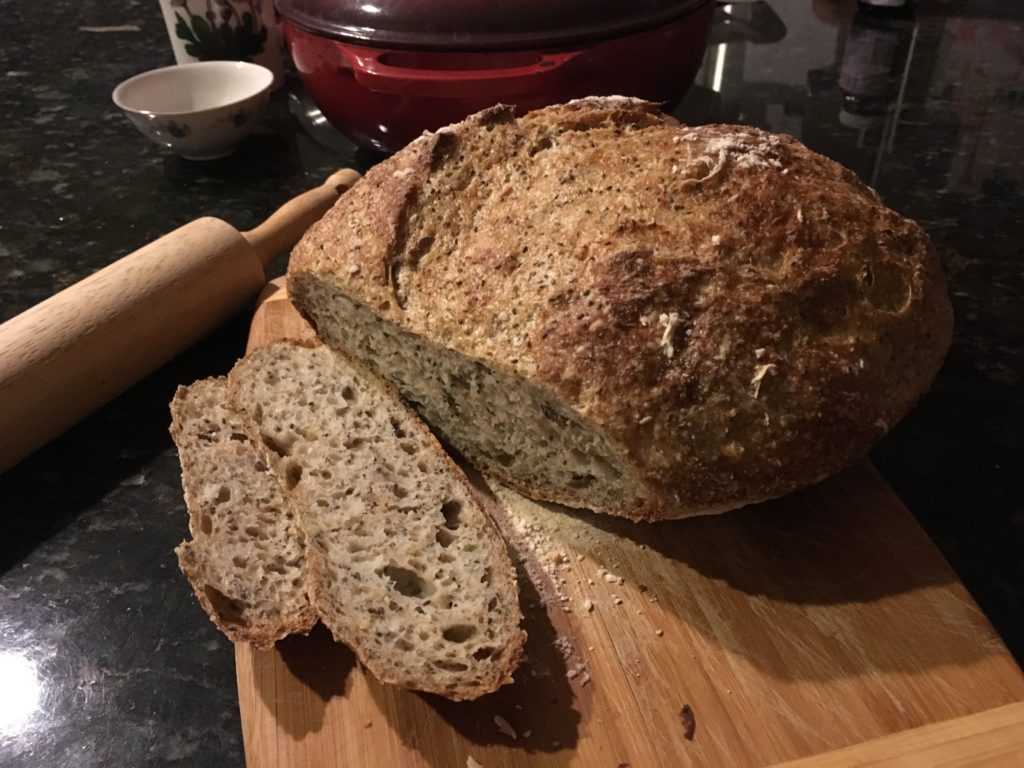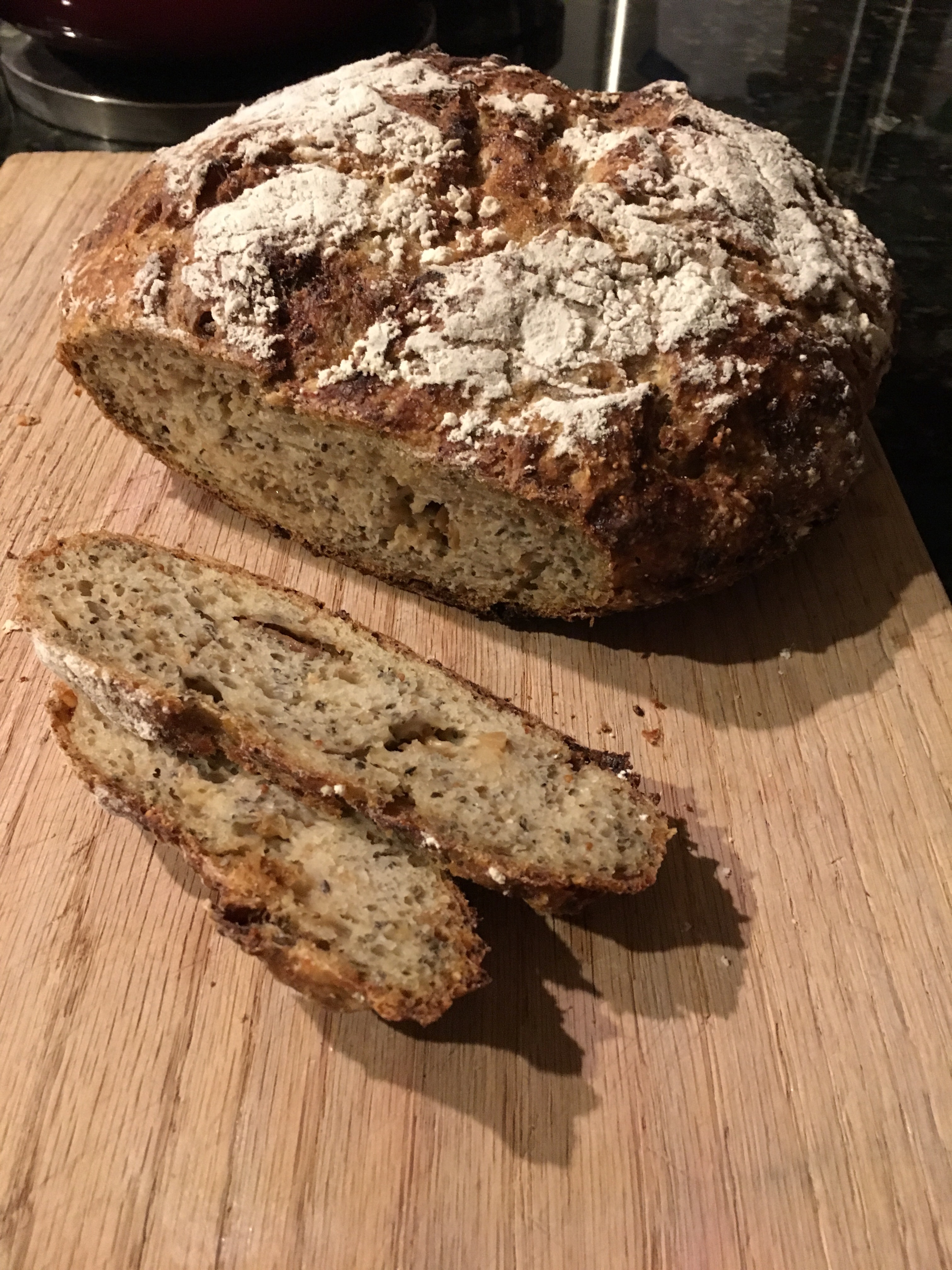Here is my basic bread recipe. It’s pretty straightforward, as long as you have a kitchen scale. The ratio is, 1 leaven: 3 water: 4 flour: .1 salt. Since my 3 quart Dutch oven limits the loaf size, that means my basic recipe is:
100g starter
300g water
400g flour
10g salt
I keep my starter mix at 100 percent, regularly fed with equal weights of flour and water. The starter lives in the fridge and is refilled whenever I bake bread or make pancakes, at least once every two weeks. It might be able to survive longer without feeding, but I’m not going to try.
I would go deeper into making the starter, except for the fact that I basically followed the instructions on Mike’s sourdough website. I really like his straightforward approach to the process. Don’t be intimidated, fermentation just happens, mix some water and flour and the germs in flour will happily do their duty. Jewish tradition considers bread to be leavened after 18 minutes, which is a wildly optimistic timeframe, but the sentiment is much closer to the truth than anyone who makes it sound like a big deal.
As for the bread itself, you can jazz it up in two ways. First you can tweak the flour itself. I’ve found that 20% whole wheat flour has minimal effect on the final product aside from making it healthier. Once you go above that, the loaf does start to get whole wheat-y. Second, you can add fun stuff. Generally my rule is +30% of flour weight of things like nuts, seeds, dried fruit, or even grain porridge. As I write, I’ve realized you should be able to actually go higher, since I was adding 7% wheat germ to the dough when I came up with that +30% rule, so it most likely means you could throw in up to forty percent in other random stuff. If you’re not sure, go ahead and presoak these extra items, since you don’t want to throw off the hydration ratio of the main dough. I would guess 150% of the weight of the fun stuff stuff is a good rule of thumb for starters (such as 60g chia seed + 90g water).
By the way, the first few of my consistently good loaves were ones with stuff added to it (such as 15% raisins + 15% walnuts). This is a completely uninformed theory, but I suspect the extra chunks acted as aggregate in concrete, making it easier to shape.
The process itself is also pretty basic: Autolyse, mix, wait a while, preheat the oven, preshape the dough, shape it again, and bake it covered, and then take off the cover, and then let the loaf rest.
- If you really want a happy starter, feed it the night before and it will be jumping the morning you mix the dough. Or you can be lazy like me and just pull it out the fridge when you’re ready to start.
- Autolyse: Mix the water into the starter. I mix in a little water at first to get a consistent sludge, before throwing in the remainder of the water. Then throw in all the flour and roughly mix it up. And then let it sit for at least 15 minutes. (I usually take this time to feed the starter and put it back in the fridge. I take this time to soak any extra goodies to throw into the dough, along with the salt. I often eat breakfast, which can result in a much longer autolyse.)
- Mix: I then throw in the salt or salted soaked goodies. This is the only time I vigorously beat up the dough. At 75% hydration it is very slack so you can’t really knead it. Instead you will go back and forth between folding and pinching the dough to get everything incorporated. (In the past, I’ve gone up to 82% hydration and its worked out, but I like the simple ratio of 3:4, so I’ve settled on this number).
- Then wait. While waiting I like to fold the dough a few times. Ideally, the first couple times will be at 15 minute intervals, and then a few more at 30 minute intervals. But I don’t stress if I don’t get around to folding it at all. After a few hours (5 to 9 in our house) the dough will look happy and ready to bake. I wish I could give good guidance, but it is truly a feel thing. Visually I look for when my dough roughly reaches most of the way towards the 2 qt line in my Cambro container. (If in doubt, just go ahead and bake. Overproofing is a complete disaster compared to underproofing. Even if you lose a little on the flavour by baking early, the dead shape and flattened texture of an overproofed loaf is real bummer.)
- Preheat and shape: I put my dutch oven (without the lid) into the range and start the preheat. For the bake, I now keep it at a simple consistent 450f throughout. While the range is heating up, I dump the dough out on the counter and preshape it using a dough knife. I then let the dough rest until the oven is at about 400f, when I’ll do a final shape, usually folding it. (However, I’m starting to doubt whether folding makes a real difference, so I am starting to try a simple second shape a dough knife instead.)
- Bake, covered: Unlike many recipes, I don’t do a second proof after the final shape. I pull out the very, very hot dutch oven, throw in the dough, snip the top 5 times with a scissor, put the not-yet-hot lid on, and throw the very, very hot dutch oven back into the range. (The big dutch oven is nice, but you can bake in any all metal pot with a lid to trap the steam for the first half hour of the bake.)
- Bake, uncovered: After 30 minutes I take off the very, very hot lid of the dutch oven, and rejoice in the rise or feel bummed if it failed. I leave the lid in the range on a lower rack because that thing is very, very hot and I don’t want to have someone accidentally pick it up.
- After another 30 minutes I pull out the very, very hot dutch oven and extract the bread with the help of a wooden spoon. I put the loaf on a rack, and put the very, very hot dutch oven back into range. Remember this dutch oven is very, very hot and you don’t want to accidentally touch that very, very hot thing.
- Rest: There are some authors who are absolutely insistent that you should let the bread rest for a few hours, though I’ve also read there is nothing like freshly baked bread right out of the oven. I’m agnostic so I just do whatever I feel like doing, which usually means I just let it sit overnight by the time the bake has happened.
And that’s it.
But before I let you go, here is some additional commentary.
If you overproof your bread, it isn’t actually the end of the world. Throw in some fresh flour (I’ll add 100g flour to my 400g flour loaf), mix it up with the dough, and give it a couple hours. But then you should have something you can shape and bake, and a dough that now coincidentally meets Ruhlman’s 5 flour:3 water ratio. I only figured out this general game plan a couple months ago, so I don’t have a fixed process yet, but know that it is salvageable.
While you are waiting for the dough to rise and you find yourself stepping out of the house for an extended period, throw the bread in the fridge and bake the next day. The long cold storage will make the bread a bit more sour, which may be a feature if you actually want sourdough to be sour. In fact, my bread made with the standard process above without refrigeration is not sour at all.
Unlike true professional bakers, I’m just happy with getting a consistently decent loaf (better than anything you can get from the supermarkets, including Whole Foods). When you read those recipe books, you’ll see authors geek out on flour, temperature, time, starter condition, etc. I grant that carefully controlling all those variables is necessary for getting the absolute best possible loaf out of the oven, but I don’t think it’s worth the stress. Instead, I follow the attitude that I came across at the back of a mud oven book at the library, where the hippie author gives a very generic sketch of instructions for sourdough and then tells the reader to enjoy what comes out.
However, I do strongly recommend geeking out with cookbooks at the library. All these books follow same pattern – sell the idea of baking your own bread, give you the basic method (this blog post), and then spend the remaining two thirds with filler (alternate recipes, the jazz it up paragraph in the post above). While at the library you should browse the shelves and flip through every bread book available, you never know where you’ll come across a random useful snippet amidst all the food porn. Here are some of my favorites:
- Chad Robertson’s Tartine 3, Ancient Grains. I love the ambition of just sticking to grains, hence why this is the only book I’ve purchased. His first Tartine book is also really good, but I’m too lazy to do a poolish which he uses for all his enriched breads.
- Ken Forkish’s Flour Salt Water Yeast. You can see I referenced a few of his videos. He is very meticulous in his process, so it is worth reading, even if I ignore most of it now.
- Jim Lahey’s My Bread. The opposite of Forkish in his lack of precision, but I don’t follow him either, since I fold a lot. It’s a fun book, worth a read and it helped me solidify my 30% goodies rule.
- Vanessa Kimbell’s The Sourdough School. This is a new book and it seems promising from the time I flipped through it. Like Robertson, she geeks out way more than necessary on the starter, but she included a few good “troubleshooting” sections which makes it worth looking up.
- Peter Reinhart has written a lot of bread books, all worth flipping through. Unfortunately he does not keep the recipies at a consistent 1000g flour increment, so it is difficult to quickly compare ratios on the fly. However, he goes through a wide variety of methods and talks quite a bit about traditional recipes so they are fun reads.
- Daniel Leader’s Local Breads. Its part travelogue and part recipe book. This is also a fun read, though apparently not that fun since I never finished it. The hand drawn art is appreciated.
- Jeffery Hamelman’s Bread, a Baker’s Book of Techniques and Recipes is a relatively encyclopedic book that covers a lot of ground. It is very substantive, and the one book that breaks the mold of being stuffed with filler.
Finally, my instructions are vague because it’s just going to take a few (or lots) failed attempts to get a feel for the dough. As such, I’d suggest doing smaller loaves so you can plow through the bummers in a short amount of time. I baked every day for three weeks before getting consistent, sometimes a couple loaves at a time for A/B tests. I could try harder to describe the right feel for things, but it would be as futile as all the books I read while fighting my failed loaves for those first three weeks.
In the end, you gotta just make it happen. So start. Now.



